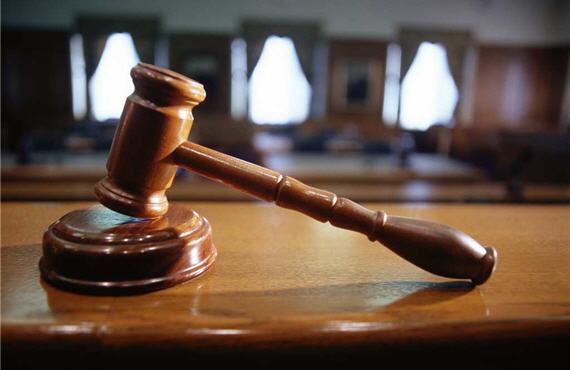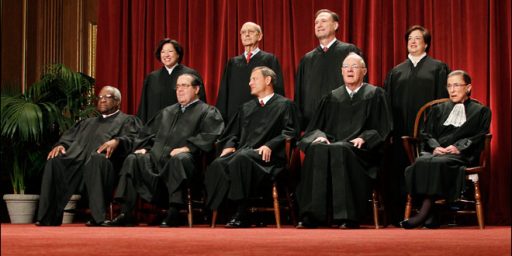Supreme Court Rejects Racially Gerrymandered Districts In North Carolina
An important redistricting decision was handed down by the Supreme Court today.
In an opinion handed down today, the Supreme Court rejected the proposed border lines for two North Carolina Congressional Districts, stating that racial bias had played a role in creating the districts:
WASHINGTON — The Supreme Court on Monday struck down two North Carolina congressional districts, ruling that lawmakers had violated the Constitution by relying too heavily on race in drawing them.
The court rejected arguments from state lawmakers that their purpose in drawing the maps was not race discrimination but partisan advantage.
Election law experts said the ruling would make it easier to challenge voting districts based partly on partisan affiliations and partly on race.
“This will lead to many more successful racial gerrymandering cases in the American South and elsewhere,” said Richard L. Hasen, a law professor at the University of California, Irvine.
Democrats welcomed the ruling.
“This is a watershed moment in the fight to end racial gerrymandering,” Eric H. Holder Jr., the former attorney general and the chairman of the National Democratic Redistricting Committee, said in a statement. “North Carolina’s maps were among the worst racial gerrymanders in the nation.”
The justices were unanimous in rejecting District 1, in the northeastern part of the state. After the 2010 census, lawmakers increased the district’s black voting-age population to 52.7 percent from 48.6 percent.
New York University Law School Professor Richard Pildes analyze the decision for Professor Rick Hasan’s Election Law blog:
The main take-away from today’s decision is that the Supreme Court is continuing the project of winding down unnecessary racial redistricting. The decision reflects the Court’s effort to modernize the Voting Rights Act (VRA) and ensure it adapts to the changing dynamics of race and politics, in some parts of the country, in the many decades since the Act first was passed. The crucial fact in today’s decision is that 30-40% of white voters in parts of North Carolina are willing to cross-over and vote for the same candidates that African American voters prefer – and that application of the VRA and the Constitution must recognize these changing realities.
The Court today shored up the constitutional constraints limiting the use of race in redistricting, which has been the main development in the law of redistricting this decade. That development began with the Alabama cases, Alabama Legislative Black Caucus v. Alabama, and has now been extended to Virginia and North Carolina. And the Court also opened up a new avenue of constraint by holding that if white voters now vote for candidates black voters prefer at high enough rates, the intentional creation of majority-black districts is no longer required – and indeed, is unconstitutional.
(…)
The most important aspect of today’s decision is the Court’s unanimous conclusion that Congressional District 1 (CD 1) is an unconstitutional racial gerrymander. It would be easy to miss that this part of the opinion is unanimous, because the Court divided 5-3 on a second district at stake, CD 12. But I have always said the most important issue in the NC case was that involving CD 1, and there, the Court agreed in unison.
With respect to CD 1, the critical point is that the Court rejected North Carolina’s argument that the VRA required it to create a majority-black district to make sure black voters had equal political opportunity. More specifically, the Court concluded that voting in this area was not racially polarized enough to require the remedy of a majority-black district.
What does it mean for voting to be racially polarized (RPV)? This has been a key concept under the VRA, yet the Court has given the concept almost no significant attention – with today’s decision being the Court’s first and thus most significant opening up of questions about this concept.
(…)
Put in other terms, the decision confirms that States must adhere to the view that the intentional creation of majority-minority districts is a “second best” remedial device, to be used only where clearly required. Indeed, important parts of the opinion further emphasize that States must have a strong record in support if they engage in race-based districting: States must do a thorough job of demonstrating that doing so is necessary – “the State must carefully evaluate” whether the facts support race-based districting, and the State must engage in a “meaningful legislative inquiry” about whether doing so is necessary.
(…)
Once again, the Court confirmed that if the State intentionally sorts voters by race into districts, the State cannot hide behind the argument that its ultimate goal was to pursue an effective partisan gerrymander. To the extent partisan gerrymandering is constitutional, States can sort voters by their voting patterns, but not by their race. As the Court has said before, race cannot be used as a “proxy” for political voting preferences. To be sure, this can create a quagmire for the lower courts if a State does not directly and obviously use race to sort voters; the courts then have to disentangle whether it was “really” race or partisan factors that drove the district’s design (I have long argued that it makes little sense for the Court to impose constitutional constraints on racial gerrymandering, but not partisan gerrymandering).
The decision in this case, to which only Justices Alito and Kennedy and Chief Justice Roberts dissented, represents the latest in a line of recent cases in which the Justices have sought to limit the ability of state legislators to use the excuse that district lines were based on desires to maintain partisan balances, which is acceptable under the rules that forbid gerrymandering based on race, when the evidence makes clear that there was a different, more sinister racial intent behind the decision. This is something that has been especially hard in the past when it came to the issue of majority-minority districts, where lines are drawn in a way that creates new Congressional districts in which minority groups are in the majority and the effect generally has been to elect a member of a minority group as a Member of Congress. With that accomplished, the advocates of the existing redistricting scheme have typically argued that it would be inequitable for a court to undo a redistricting scheme that has allegedly increased the political power of minorities by providing them with a voice in Congress. Creation of these majority-minority districts, of course, has the secondary impact of drawing minority residents away from surrounding districts and making them much less racially balanced than they would have been had district lines not be drawn with ethnicity and race being a conscious factor in the mind of the legislature.
While some Courts have seemingly accepted this line of reasoning, recent decisions of the Supreme Court have rejected it in favor of the idea stated above, namely that intentionally creating majority-minority is, at best, a secondary choice that legislatures should make when deciding how to draw district lines, and that legislators should engage in such activity only in situations where it is clearly required. As Pildes notes, the Courts have stated that this recent line of cases generally requires states to have built a strong evidentiary case in favor of their decision to intentionally create a majority-minority district and the legislature must have engaged in a ‘meaningful inquiry’ regarding whether creating such a district is absolutely necessary. All of this requires courts asked to review district lines to engage in often complicated fact-finding in order to determine whether or not a particular redistricting scheme is based on race, which is barred under the Constitution, or on politics or some other consideration, which is constitutionally permissible. Obviously, this becomes harder depending on the state of the record with regard to legislative intent.
The immediate consequences of today’s decision, of course, will fall largely on the state of North Carolina as legislators will be required to once again go back to the drawing board in an effort to draw district lines that could pass muster under the standards that have been by the Court. If the legislature is unable to agree, then the alternative is likely to be that they will have such a redistricting scheme imposed upon them by the District Court that originally heard the cases. Beyond that, though, this ruling, along with those that came before it, will go a long way toward impacting how redistricting is carried out in other states where the lines of some districts are still being contested even at this point. Additionally, it will have a huge impact on the plan for the redistricting that will have to take place in the wake of the 2020 Census, which is only three years away. Another potential impact from all of this, of course, is that we will see a reduction in the number of minority members of the House of Representatives. The Justices are no doubt aware of this, though, and are willing to take that risk. In the long run, the Court is sending the message that the use of race-specific criteria in the creation of Congressional Districts is becoming pretty close to being a per se violation of the law and the Constitution, and that’s more important than the level of minority membership in Congress.
Note: This post was updated to reflect a change in the designation of the vote breakdown in the Court. The dissenters were Justices Kennedy, Alito, and Chief Justice Roberts. Justice Thomas joined the largely liberal majority in the result and filed a concurrence in the case.
Here’s the opinion:
Cooper et al v. Harris et al, by Doug Mataconis on Scribd






“only Justices Alito and Thomas and Chief Justice Roberts dissented”
Thomas was in the majority, but also filed a concurrence. Kennedy dissented.
When even Thomas can’t ignore it….
@Moosebreath:
Thanks for the heads up, I let that one slip by
@Doug Mataconis:
I noticed it only because I saw a comment elsewhere on what a strange alignment it was.
@Davebo:
This doesn’t surprise. Thomas has always taken a very dim view of race-based gerrymandering, including that done for the VRA.
The more I think about this kind of stuff, the more I favor multi-member districts and some proportional voting method (lists, STV). Oh, and of course, I favor dramatically increasing the size of the House.